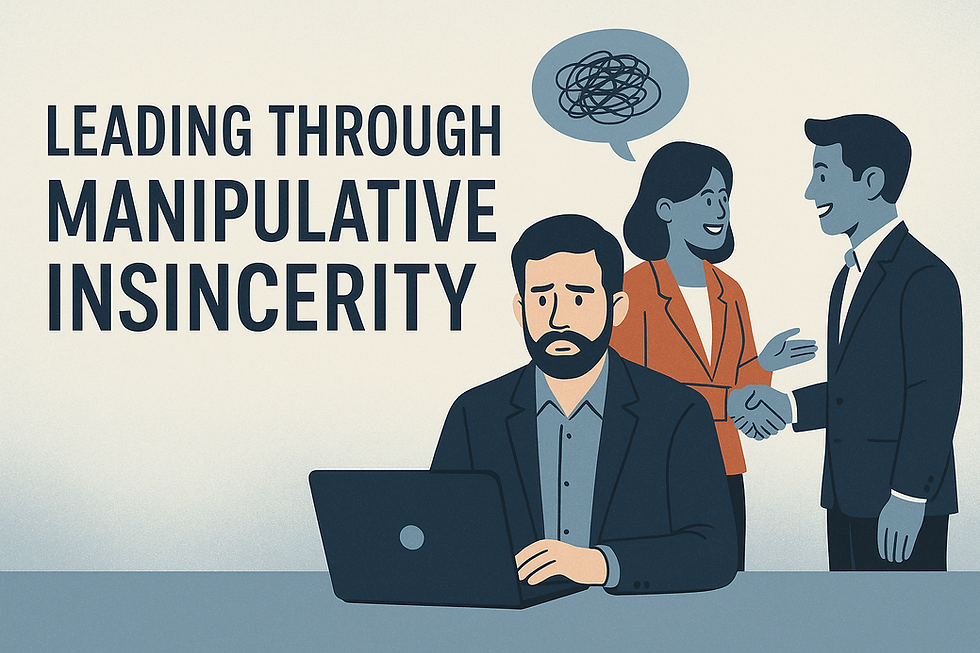Leading Through Manipulative Insincerity: Confronting the Quietest Threat to Team Culture
- Joe Glaser

- Jul 25
- 5 min read

I’ll be honest—this isn’t the kind of topic I typically enjoy writing about. I prefer to focus on the inspiring side of leadership: the breakthroughs, the courageous conversations, the small wins that lead to big transformations. But the reality is this—great leadership doesn’t happen in perfect conditions.
It happens in the tension. In the misunderstandings. In the hurt.
And if we’re going to lead well, we need to talk about one of the most damaging—yet often invisible—threats to healthy culture: manipulative insincerity.
🔍 What Is Manipulative Insincerity?
Coined in Kim Scott’s Radical Candor framework, Manipulative Insincerity is what happens when someone:
Doesn’t care personally, and
Doesn’t challenge directly
Instead of healthy conflict, you get backdoor criticism. Instead of open feedback, you get passive aggression. Instead of collaboration, you get self-preservation.
It’s the quiet killer of trust, morale, and momentum—and it’s more common than we like to admit.
💢 Why It’s So Dangerous
What makes this behavior so insidious is that it's often wrapped in charisma or likability. These individuals can seem cooperative, even helpful—but their real feedback never reaches the person who needs to hear it.
Instead:
They nod in meetings but roll their eyes afterward.
They tell leaders what they want to hear but privately resist change.
They smile at peers while quietly undercutting their credibility.
The result? Confusion. Division. Exhaustion.
Because when people don’t know who to trust, they stop trusting anyone.
🔦 I’ve Been There
I’ve led teams where this showed up. Peers who were all-in—until accountability arrived. Employees who said the right things—but did the opposite when no one was looking. Leaders who acted like allies—but played politics behind closed doors.
It’s one of the hardest dynamics to navigate—because it’s not always what’s said, it’s what’s unsaid.
And let me be honest: I’ve also had moments where I failed to confront it fast enough. I gave the benefit of the doubt. I waited too long, hoping the culture would correct itself. It didn’t. It festered.
I’ve learned the hard way—this behavior must be named, challenged, and addressed.
🔧 How to Lead Through Manipulative Insincerity
Here’s what I’ve learned works when managing people (or peers) who operate in this quadrant:
1. Name It with Candor and Calm
You don’t need to accuse—but you do need to address.
“I’ve noticed that in meetings you agree, but in side conversations you express concern. I want us to be able to bring that feedback forward transparently. Can we talk about that?”
When you put behavior in the light, it loses its power.
2. Raise the Standards for Communication
Create a team norm: “Say it to the person, not just about the person.”
Model this relentlessly. Praise it publicly. Make it clear: healthy teams talk with each other, not about each other.
3. Hold the Mirror—Not Just the Line
Ask questions like:
“What’s your intention with that comment?”
“How does that help us move forward?”
“Have you brought that to them directly yet?”
Sometimes, this kind of behavior stems from insecurity—not malice. You can help someone grow if they’re willing to see the gap.
4. Protect the Culture at All Costs
If you’ve coached it and it hasn’t changed—act. This is where leadership gets lonely but necessary.
A high performer who erodes trust is still a net loss. You don’t need perfect people. But you need honest ones.
🛡️ When You’re the Target: Leading Yourself Through Manipulative Insincerity
Let’s talk about what it feels like when you’re the one being targeted.
Maybe you found out a peer who smiled in meetings was undermining your credibility to others. Maybe you confided in someone, only to discover they used your words to elevate themselves. Maybe someone quietly sabotaged your influence while keeping up appearances.
Being on the receiving end of manipulative insincerity doesn’t just frustrate you—it can make you question your instincts, your worth, even your sanity.
I’ve been there.
And if that’s where you are right now, here’s how to navigate it while protecting both your peace and your integrity:
1. Trust What You’re Seeing and Feeling
Gaslighting is often unintentional—but it’s real. When someone’s words and actions consistently don’t match, that is a red flag. If you feel the tension, don’t brush it off. Don’t second-guess yourself to avoid discomfort. Name it—at least internally.
Awareness is the first step back to clarity.
2. Don’t Take the Bait
Manipulative behavior thrives on reaction. It wants you defensive, insecure, or explosive—so it can point the finger back at you.
Stay grounded. Stay factual. Stay professional.
Don’t play chess with someone who’s not even playing the same game. Lead above it.
3. Document Interactions (Yes, Really)
This isn’t about paranoia. It’s about protecting your perspective.
Keep a log of situations that feel misaligned—times when what was said in private didn’t match public action, or where your voice was misrepresented. Should you ever need to escalate or clarify, you’ll be ready—not reactive.
4. Set Boundaries Without Bitterness
This one’s hard—but necessary. If someone has shown you they can’t be trusted with your transparency, it’s okay to pull back without resentment.
You can limit access without losing kindness. You can protect your peace without compromising your character.
5. Have the Hard Conversation—If It Serves Healing
If you believe there’s a chance for resolution—and the other person may be unaware of the impact—have the conversation.
Use Radical Candor:
“I’ve felt tension between what we discuss privately and what plays out publicly. I want to bring it forward because trust matters to me.”
But if you already know this person isn’t interested in growth—don’t force it. Your energy is too valuable.
6. Keep Showing Up in Integrity
Here’s the kicker: when you’re being targeted, the greatest test is staying true to who you are.
Let their behavior refine you, not define you. Let it sharpen your discernment, not harden your heart.
You don’t have to play the same game. You get to play a better one.
🧭 Check Yourself: Stay the North Star
Here’s something just as important as managing others—managing yourself.
We all have moments of frustration. Times we vent. Times we say something behind closed doors we wouldn’t say directly. It’s human. But unchecked, it can slip into the very behavior we’re trying to eliminate.
So ask yourself:
Am I avoiding a tough conversation that needs to happen?
Am I being honest and kind—or just one of the two?
Am I saying things in private I wouldn’t say in front of the person?
Leadership starts with alignment. And your team watches more than they listen.
Be the North Star. When in doubt—model it. Speak it. Live it.
The greatest antidote to manipulative insincerity is a leader who practices Radical Candor with consistency and heart.
🎯 Final Thought
You cannot build a high-trust, high-impact culture in the presence of manipulative insincerity. It’s not about conflict—it’s about clarity. It’s about consistency. It’s about courage.
And when you lead with heart and backbone—you don’t just manage around toxicity. You transform it.
Let’s keep leading real.
— Joe Glaser




Comments